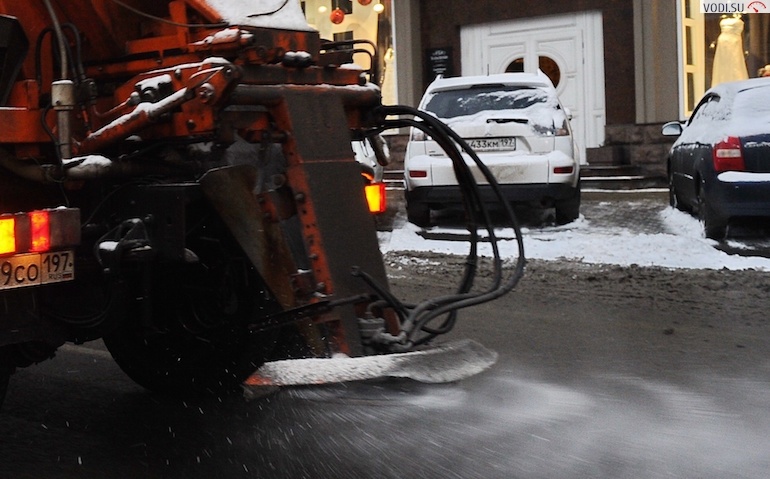
What do roads cover in winter? What reagents are used in Russia?
We have written more than once on our automotive portal Vodi.su that winter is a difficult time for motorists for a number of reasons:
- increased fuel and oil consumption;
- it is difficult to start the engine in cold weather;
- the need to switch to winter tires;
- you need to be able to drive a car on slippery roads.
Another important problem is anti-icing reagents, which are sprinkled on roads to combat ice and snow. Because of these chemical materials, the paintwork suffers, corrosion appears faster, and tires wear out.

What is it that public utilities pour on the roads in winter? Let's deal with this issue in this article.
The first thing that comes to mind is salt. However, it would be too expensive to sprinkle common table salt on the streets, so technically modified salt is used. The full name of this composition is liquid solution of modified sodium chloride. It is he who is used today in the capital.
The main advantages of this substance:
- consumption is 30-40% less than technical salt;
- the ability to melt ice in severe frosts - minus 35 degrees;
- they can be sprinkled on both highways and sidewalks.
In order to make the consumption even more economical, not just this reagent is used, but various mixtures are made:
- gravel crumb;
- sand;
- crushed stone (screening out crushed granite, that is, the smallest fraction);
- marble chips.
According to numerous environmental reviews, these compounds do not adversely affect the environment. But any driver and pedestrian will confirm that in the spring, when everything begins to melt, because of all this crumbs, a lot of dirt is formed, which is then washed away by downpours into rivers and lakes. In addition, it clogs storm drains.
There are also certain negative points, for example, a short duration of action (3 hours), so it is sprayed several times a day.

Other reagents
Bischofite (magnesium chloride) - together with it, a variety of elements are used (bromine, iodine, zinc, iron). It is worth saying that bischofite is considered much more effective than salt, because it not only causes the ice to melt, but also absorbs the resulting moisture. It does not stain clothes or paintwork, but it can cause rapid corrosion. This reagent is successfully used not only in Moscow, but also in other regions, for example, in Rostov-on-Don, Voronezh, Tambov.
However, it is worth noting that it was decided to abandon the reagents developed on the basis of magnesium chloride, for example, Biomag, since magnesium anions accumulate in large quantities in the soil, causing its salinization and the death of plantings. In addition, due to the phosphates that make up this product, a thin oil film forms on the road surface, due to which the adhesion of the wheels to the surface deteriorates.
Technical salt (halite) - the same ordinary salt, but with a low level of purification. Its layers are formed where rivers once flowed, there were large lakes or seas, but, as a result of geological and climatic transformations on the planet, they disappeared over time.
Sand-salt mixture began to be used in the 1960s.
However, since the beginning of the 2000s, it has been abandoned in Moscow due to such negative consequences:
- corrodes the paintwork of cars;
- causes significant damage to clothes and shoes of pedestrians;
- salt, along with melted snow, is absorbed into the ground or washed into rivers, leading to salinization of the soil.
Among the advantages, one can single out high efficiency and low cost - today it is the most affordable reagent.

Modified calcium chloride - calcium salt. It is also used in the form of a solution, due to which the consumption is significantly reduced.
In large cities, this remedy was abandoned because:
- it has a limited duration, after which it dissolves and attracts moisture;
- bad for health - can cause allergic reactions;
- spoils rubber products, tires, shoes, can cause corrosion.
Let's also say that the most effective substances are constantly being searched for, the impact of which on the environment, human health, and paintwork would be minimal.
So, as an experiment, in some regions, the composition of Biodor is used, which is a mixture of potassium and magnesium salts, as well as special additives to minimize the harmful effects.
Loading…